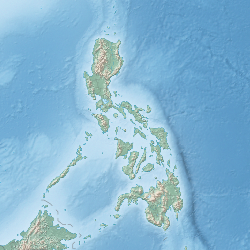| Maria Cristina Falls | |
|---|---|
 | |
 | |
| Location | Iligan City, Lanao del Norte, Philippines |
| Coordinates | 8°10′59.38″N124°11′42.14″E / 8.1831611°N 124.1950389°E |
| Type | Plunge |
| Total height | 98 m (321.5 ft) |
| Number of drops | 2 |
| Longest drop | 98 m (321.5 ft) |
| Watercourse | Agus River |
| Average flow rate | 130 m3 (4,600 cu ft) |
Maria Cristina Falls is a waterfall of the Agus River in the Northern Mindanao region of the Philippines. It is sometimes called the "twin falls" as the flow is separated by a rock at the brink of the waterfall. [1] The name come from the Spanish queen, Maria Christina of Austria. It is located 9.3 kilometers away southwest of Iligan City at the boundaries of Barangays Maria Cristina, Ditucalan, and Buru-un. [2] Known for its natural grandeur, the 321.5 feet (98.0 meters) high waterfall [3] is also the primary source of electric power for the city's industries, being harnessed by the Agus VI Hydroelectric Plant. [4]
